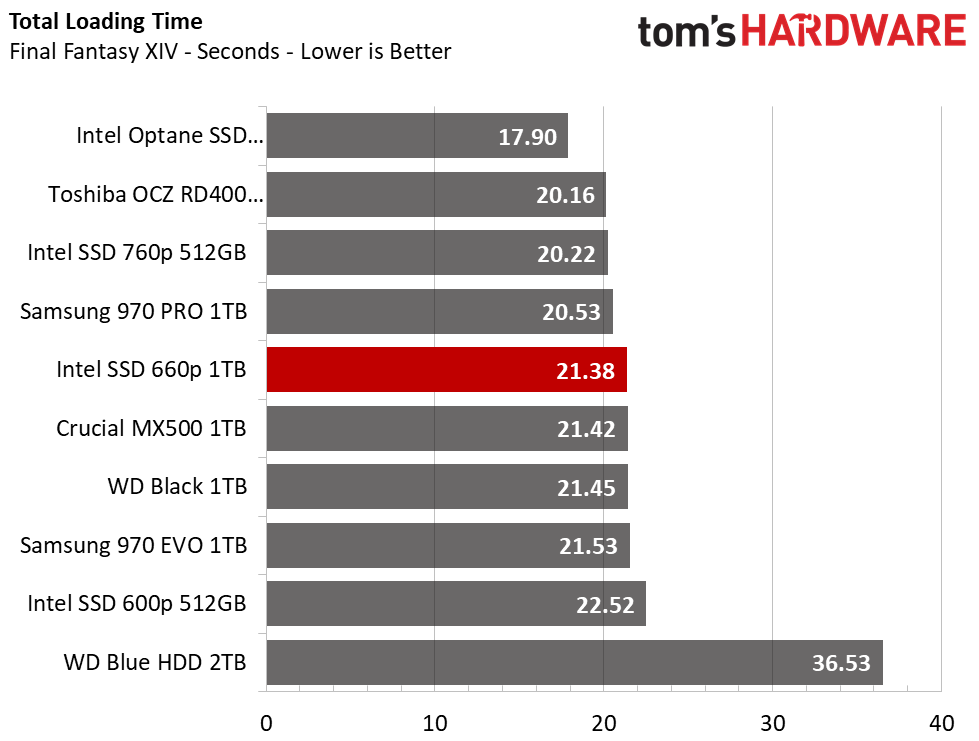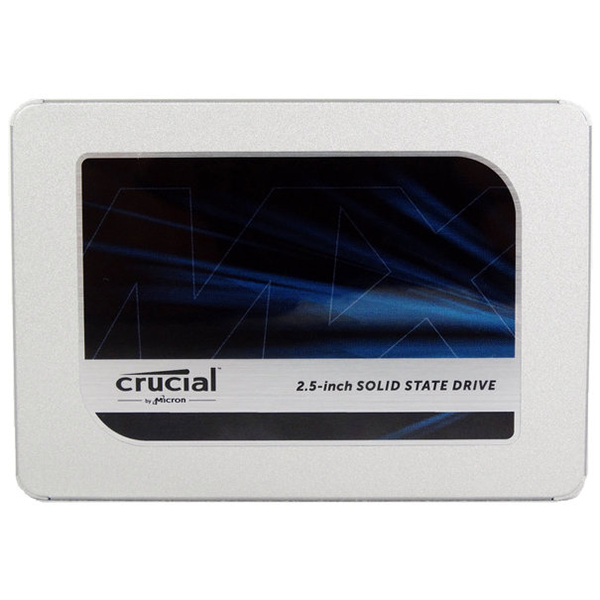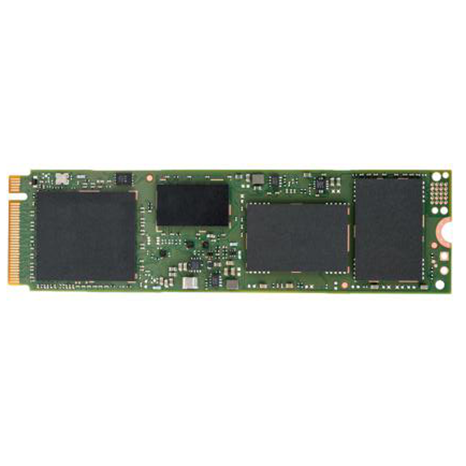Intel SSD 660p 2TB Review: a QLC Bargain (Update)
Why you can trust Tom's Hardware
Intel 660p SSD (1TB)
Pros:
- High-capacity M.2 2280 NVMe SSD
- Low price point
- Real world workload performance
- Power efficient
- SSD Toolbox
Cons:
- Low endurance
Verdict: The Intel SSD 660p offers high capacity, solid performance in real-world workloads, and impressive power efficiency at an incredibly-low price.
1TB Performance Results
Intel designed the 660p to offer the performance of blistering fast NVMe SSDs, but at SATA price points. We selected a popular SATA drive, the Crucial MX500, and a few NVMe options for our test pool. We also included the Intel 600p that comes armed with Intel's first-gen 32-layer TLC flash. Intel equipped the 760p, which is the 660p’s high-performance brother, with its current-gen 64-layer 3D TLC.
Our comparisons wouldn’t be complete without throwing Samsung’s 970 EVO and PRO into the mix. Both utilize Samsung's proprietary SSD controllers. The 970 EVO features 64-layer 3D TLC flash while the 970 PRO uses 64-layer MLC.
WD paired the Black SSD with SanDisk's 64-layer 3D TLC. The RD400 is the only SSD in the group that doesn’t have 3D NAND. Instead, it hearkens back to the good old days of 15nm planar MLC. The WD Black and Toshiba OCZ RD400 both feature proprietary SSD controllers.
Trace Testing – PCMark 8 Storage Test 2.0

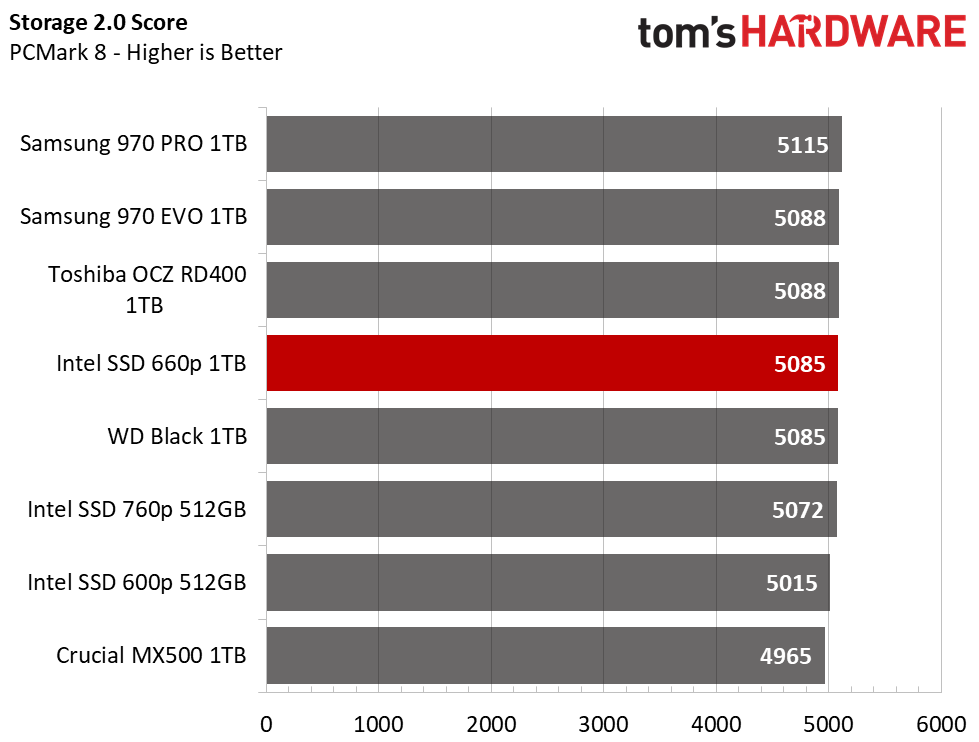
PCMark 8 is a trace-based benchmark that uses Microsoft Office, Adobe Creative Suite, World of Warcraft, and Battlefield 3 to measure the performance of storage devices in real-world scenarios.
Get Tom's Hardware's best news and in-depth reviews, straight to your inbox.
The Intel 660p trails behind the Samsung 970 series and the RD400 with a total score of 5085 and an average bandwidth of 574 MB/s. Surprisingly, it ties the WD Black with nearly identical scores and bandwidth. It beats both the 600p and the 760p, which is quite the feat considering the 760p is in a higher price tier.
Game Scene Loading - Final Fantasy XIV
The Final Fantasy XIV StormBlood benchmark is a free real-world game benchmark that easily and accurately compares game load times without the inaccuracy of using a stopwatch.
The Intel 660p matches the WD Black with a total game scene load time of 21.38 seconds. This time the 760p outperforms the 660p slightly. An SSD is much faster than an HDD, but the difference between different models is slight.
Transfer Rates – DiskBench

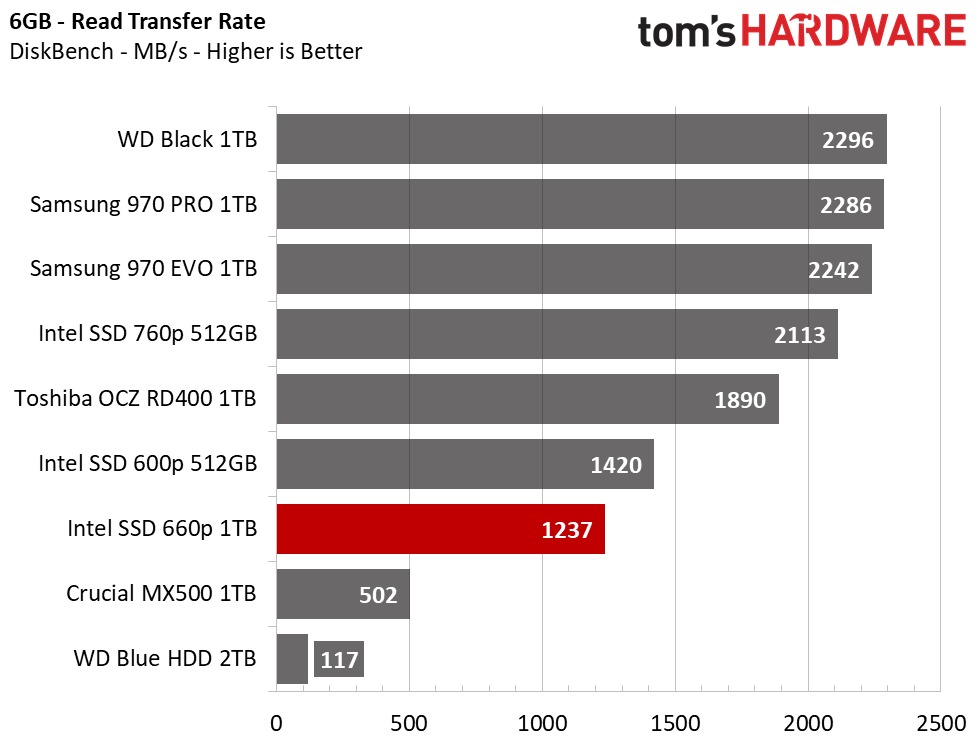

We use the DiskBench storage benchmarking tool to test file transfer performance with our own custom 50GB block of data. Our data set includes 31,227 files of various types, like pictures, PDFs, and videos. We copy the files to a new folder and then follow up with a read test of a newly-written 6GB file.
The 660p scores an impress average speed of 291MB/s during the file transfer. That's almost as fast as the RD400 and easily outpaces the Intel 760p, 600p, and Crucial MX500 SATA SSD. The 660p's copy performance is impressive, but the 1.2 GB/s file read speed is slower than the rest of the NVMe SSDs in our test pool.
SYSmark 2014 SE
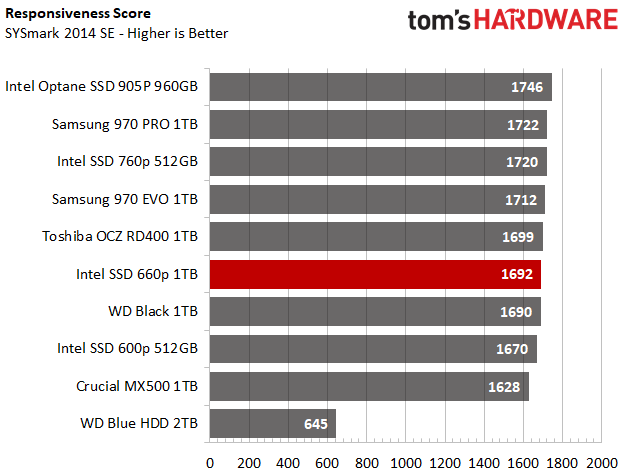

Like PCMark, SYSmark uses real applications to measure system performance. SYSmark takes things much further, however. It utilizes fourteen different applications to run real application workloads with real data sets to measure how overall system performance impacts the user experience. BAPCo's SYSmark 2014 SE installs a full suite of applications for its tests, which includes Microsoft Office, Google Chrome, Corel WinZip, several Adobe software applications, and GIMP. That also makes it a great test to measure the amount of time it takes to install widely-used programs after you install a fresh operating system.
Installing SYSmark proved to be a challenge for the Intel SSDs. The application installed faster on competing drives, including the MX500 SATA SSD. After installation, the 660p delivered a responsiveness score of 1692. That's just seven points shy of the RD400 and two points above the WD Black.
ATTO


ATTO is a simple and free application that SSD vendors commonly use to assign sequential performance specifications to their products. It also gives us insight into how the device handles different file sizes.
The Intel SSD 660p delivers faster small file read performance than the Intel SSD 600p until the test reaches the 512KB file size. It also outperforms the 600p and even the high-performance 760p during write workloads.
Anvil's Storage Utilities
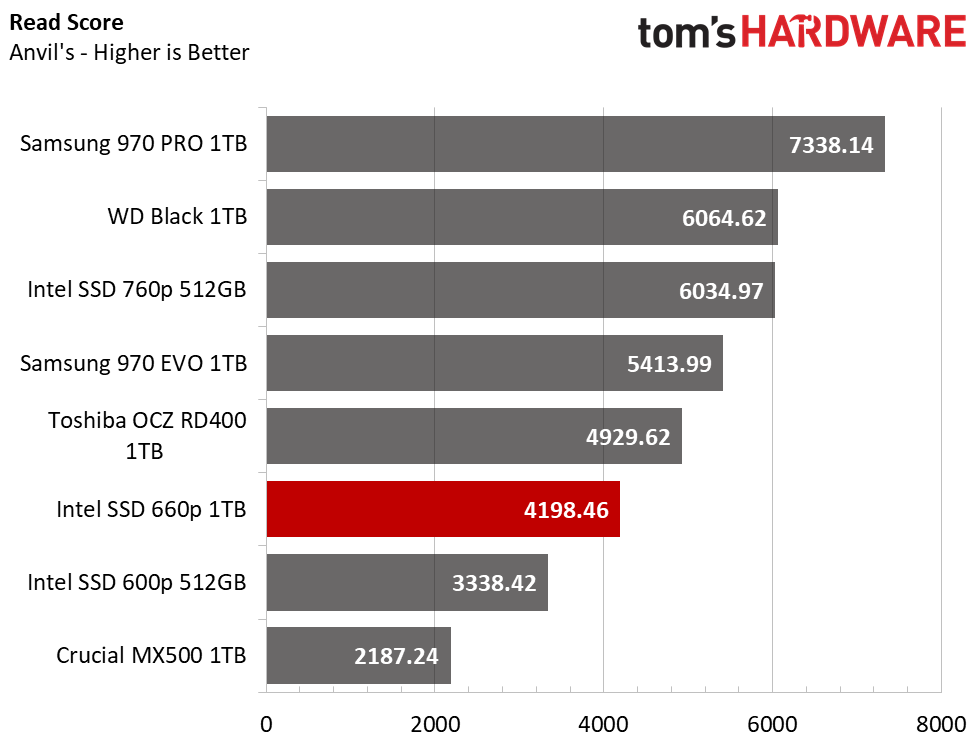
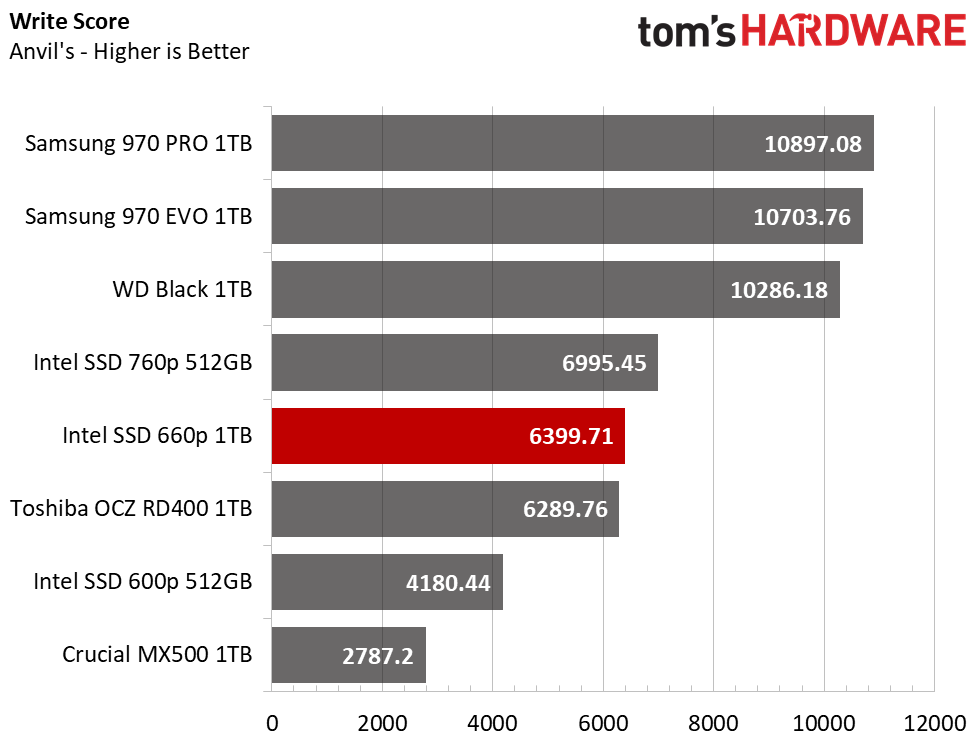
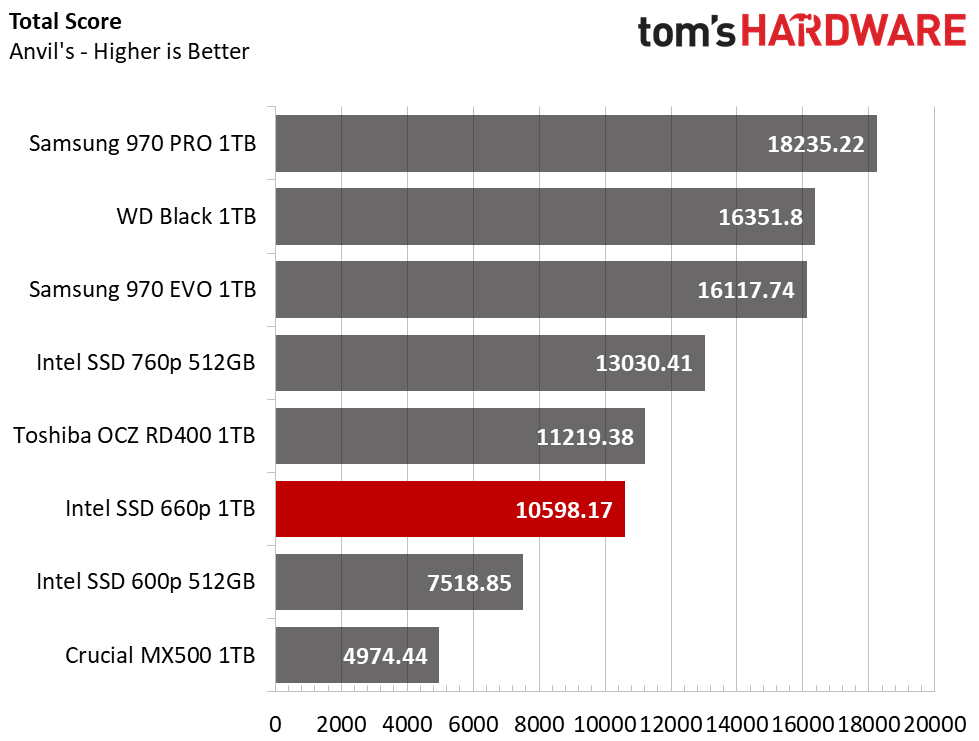
Anvil's Storage Utility is a commonly-referenced benchmark that simplifies the complex IOMETER benchmark and its underlying Dynamo engine with a one-click software wrapper.
The 660p's overall score beats the MX500 and 600p. However, it trails behind the likes of Samsung, WD, and Toshiba due to its lower read and write performance.
CrystalDiskMark
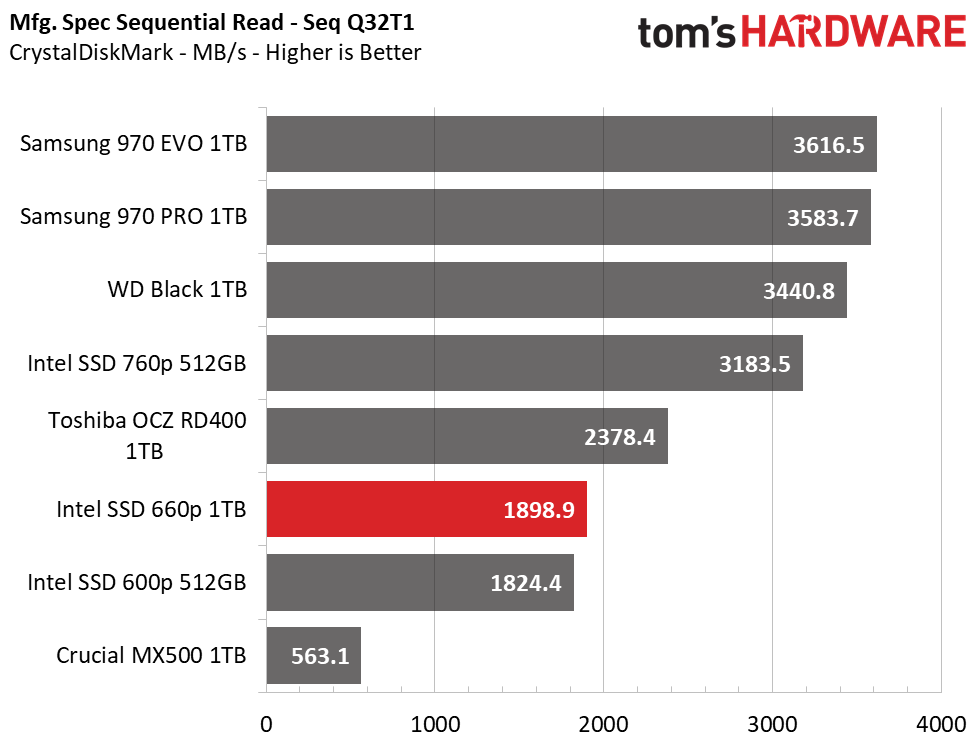


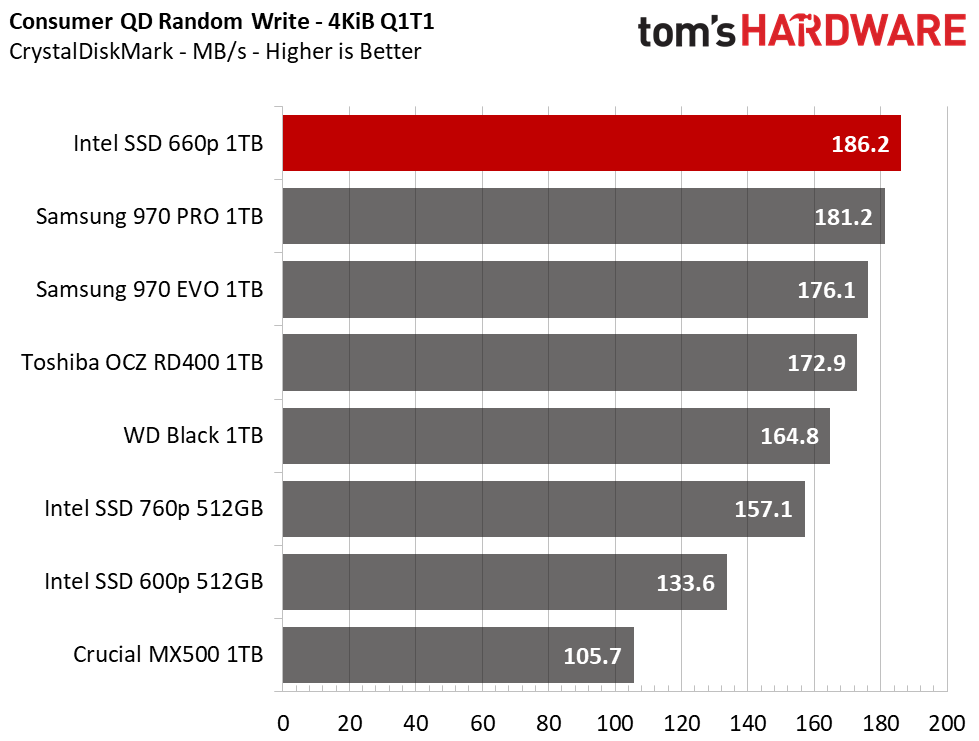

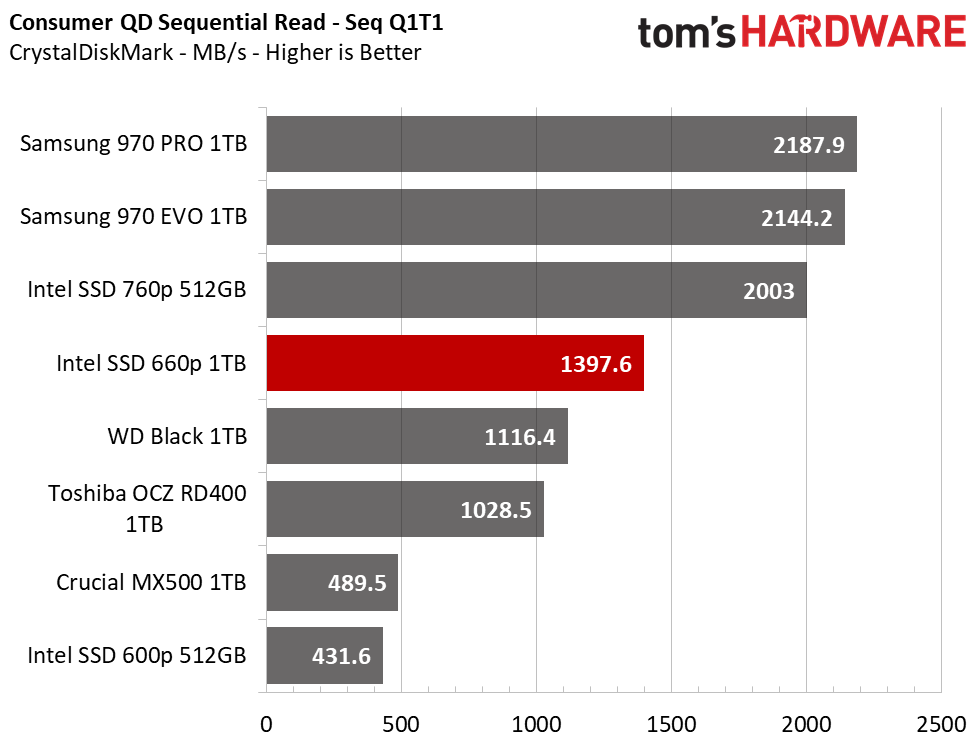


CrystalDiskMark is a simple and easy to use benchmarking tool. The 660p’s read and write results match the manufacturer’s 1.8 GB/s read and write specifications. It displays impressive random read performance and strong random write performance. It even outperforms the Samsung 970 series during 4KB random read and write workloads at a queue depth of one.
Power Consumption
We use the Quarch XLC Programmable Power Module to gain a deeper understanding of power characteristics. Idle power consumption is a very important aspect to consider, especially if you're looking for a new drive for your laptop. Some SSDs can consume watts of power at idle while better-suited ones sip just milliwatts. Average workload power consumption and max consumption are two other important aspects. You might think that lower power consumption is better than high peak values, but performance-per-watt is more important. A drive might consume more power during any given workload, but accomplishing a task faster allows the drive to drop into an idle state faster, which ultimately saves power.





The Intel SSD 660p is one of the most efficient SSDs in our comparison pool. The 660p consumed just 2.31 watts of power during our 50GB file transfer. That equates to 126 MB/s of throughput per watt. Intel also keeps maximum power in check: The drive peaked at just 4 watts during the test. The more power-hungry drives consumed over 7 watts at peak utilization.
A quick glance at our power measurements indicates that manufacturers are still working out the power optimization kinks with the PCIe interface. Intel and Samsung seem to have a firm grasp on it, but WD and Toshiba have a lot of room for improvement. The 660p idles at under 700mW of power without the use of ASPM, but once it is enabled, power consumption improves to just 33mW. That makes the 660p the most power efficient NVMe drive we've tested to date.
Comparison Products
MORE: Best SSDs
MORE: How We Test HDDs And SSDs
MORE: All SSD Content

Sean is a Contributing Editor at Tom’s Hardware US, covering storage hardware.
-
Giroro What is the real capacity of the 1TB drive?Reply
I really doubt the "raw" capacity really matches what the user sees, which is what the table says. So how much over-provisioning is Intel using with QLC compared to TLC?
Also, is hitting the endurance limits actually covered by the warranty? Or is Intel just planing on replacing a bunch of drives as they wear out in a year or two? Because, to me, calling 100 TBW endurance poor is an understatement. It's about one third of the TLC drives (which is not the same thing as "33% lower" by the way), and the TLC drives themselves have somewhat mediocre endurance.
Personally, I don't think a slightly lower price is worth the hassle and cost of replacing your SSD three times as often. I could buy 1 x 760p at $140 retail, or 3 x 660p for a total of $300 retail. That math doesn't work out for me. Plus, the 760p of the same capacity will have superior performance, which will be more clear when Toms reviews the 1TB 760p or the 512GB 660p, so there can be a direct comparison.
I think what is most annoying about QLC drives, is that cheap laptop OEMs are going to switch to them almost immediately, slap a 1 year warranty on the whole computer, then you are SOL when the drive wears out in 18 months. Intel will refuse to cover non-retail drives and just refer you back to the laptop OEM. Plus it's usually super annoying to repair/replace/upgrade the SSD in a laptop if you actually need to transfer any data. -
Paul Alcorn Reply21211903 said:What is the real capacity of the 1TB drive?
I really doubt the "raw" capacity really matches what the user sees, which is what the table says. So how much over-provisioning is Intel using with QLC compared to TLC?
Also, is hitting the endurance limits actually covered by the warranty? Or is Intel just planing on replacing a bunch of drives as they wear out in a year or two? Because, to me, calling 100 TBW endurance poor is an understatement. It's about one third of the TLC drives (which is not the same thing as "33% lower" by the way), and the TLC drives themselves have somewhat mediocre endurance.
Personally, I don't think a slightly lower price is worth the hassle and cost of replacing your SSD three times as often. I could buy 1 x 760p at $140 retail, or 3 x 660p for a total of $300 retail. That math doesn't work out for me. Plus, the 760p of the same capacity will have superior performance, which will be more clear when Toms reviews the 1TB 760p or the 512GB 660p, so there can be a direct comparison.
I think what is most annoying about QLC drives, is that cheap laptop OEMs are going to switch to them almost immediately, slap a 1 year warranty on the whole computer, then you are SOL when the drive wears out in 18 months. Intel will refuse to cover non-retail drives and just refer you back to the laptop OEM. Plus it's usually super annoying to repair/replace/upgrade the SSD in a laptop if you actually need to transfer any data.
It is important to remember how SSD endurance is measured.
The workload consists of a 4K random write to the full span of the drive while it is completely full of data. From an SSDs viewpoint, this is the absolute worst case scenario imaginable. The drive is full, which reduces its ability to boost endurance using common methods, like write combining or effective garbage collection, etc, so it forces the drive to not operate, or boost endurance, as it would normally.
The workload spans the entire space of the drive, which again just doesn't happen in normal application. SNIA guidelines for client SSD testing recommend a 16GB span, which changes the nature of the workload, and the impact to endurance. And a 16GB span is still far too large, imo.
These two factors magnify the impact to endurance to unrealistic levels, but the use of a 4K random write workload is even more brutal. Think of it as taking a shotgun to the flash. If you measure endurance with a sequential workload under the same sub-optimal and unrealistic conditions, the flash provides anywhere from 5x to 12x more endurance.
Also, endurance is rated by data retention, which is a function of time. The criteria for data retention is that after the endurance rating has been exhausted, you must be able to read back the data after the drive has set unpowered for a year.
So, during normal use the drive is not full to the extreme, which leads to increased endurance because the drive can operate correctly and mitigate the impact to endurance, and the workload does not span the full LBA range, which leads to increased endurance. Heavy pure 4K random write workloads are as rare as they come in a consumer desktop environment (even in the enterprise they are extremely rare), so the actual amount of data you can write during a typical mix of sequential and random workloads isn't even in the vicinity of the official endurance rating. Even after all that, if the endurance is exhausted and you keep the drive powered on a semi-regular basis (say, powering it up every six months), the amount of time before you would have an issue with data retention is lengthened.
In short, during real world use the SSD can handle far far beyond this rated endurance spec. -
DXRick PAULALCORN said "...you must be able to read back the data after the drive has set unpowered for a year."Reply
I built my current PC with a 1TB Black Edition WD around 7 years ago. So, that means there are files that have been sitting there for 7 years that have not degraded and are still 100% readable, or I would have serious problems. I would need an SSD to do the same in my next build. 1 year isn't a long enough retention period for, and given we aren't supposed to defrag SSDs I don't see what would cause some files to get re-written to another part of the drive.
Is there a weakness with SSDs for the lifetime of data that just sits there and is never updated?
Thanks! -
Paul Alcorn Reply21212567 said:PAULALCORN said "...you must be able to read back the data after the drive has set unpowered for a year."
I built my current PC with a 1TB Black Edition WD around 7 years ago. So, that means there are files that have been sitting there for 7 years that have not degraded and are still 100% readable, or I would have serious problems. I would need an SSD to do the same in my next build. 1 year isn't a long enough retention period for, and given we aren't supposed to defrag SSDs I don't see what would cause some files to get re-written to another part of the drive.
Is there a weakness with SSDs for the lifetime of data that just sits there and is never updated?
Thanks!
You haven't powered the computer up for a year? As in, turned it on?
The statement is about the SSD not being powered for a year. Turned off.
-
richardvday Yes I think your missing the part about NO POWER to the drive for a year.Reply
If you power your system up every 11 months( if you leave it off that long cant be important can it ?) it should still work is what he is saying.
A HDD on the other hand can sit off for much longer and still retain your data.
Just power it up everytime DST kicks in every 6 months :) -
unityole though I do like added power test during use not just idle, whats with the review tests seems all changed. we longer see seq read/write nor random read/write performance at QD1-4.Reply
further more with TLC especially more so on QLC, I want to see the speed while saturated by write to see the real write performance of QLC flash. please include a HD tune test write test entire drive so we can see the dip in performance going from SLC caching being filled to real QLC performance. -
cryoburner Reply
How many people are actually going to write 100,000GB of data to any drive? Under most typical usage scenarios, the vast majority of people won't be writing more than 20GB of data to their system drive each day, and most common users will write far less than that, maybe averaging a few GB or so. Even at 20GB per day, which would actually be rather high, it would take more than 13 years to hit that amount of writes, so the suggestion of having to replace the drive more often is nonsensical. By that point, the drive should be long obsolete, and you'll likely be able to get much faster, higher capacity drives at a fraction of the cost. So, no, I don't see 100TBW endurance being a problem. To hit that amount of usage within the drive's 5 year warranty, you would need to write around 55GB of data to the drive each day, and that's not going to be something likely to happen outside of certain specialized professional tasks. Obviously, hitting the write endurance limit won't be covered by warranty, but it's not something likely to happen within the drive's warranty period either. And 100TBW is for the 512GB drive, not the 1TB drive reviewed here, which has double the endurance.21211903 said:Also, is hitting the endurance limits actually covered by the warranty? Or is Intel just planing on replacing a bunch of drives as they wear out in a year or two? Because, to me, calling 100 TBW endurance poor is an understatement. It's about one third of the TLC drives (which is not the same thing as "33% lower" by the way), and the TLC drives themselves have somewhat mediocre endurance.
Personally, I don't think a slightly lower price is worth the hassle and cost of replacing your SSD three times as often. I could buy 1 x 760p at $140 retail, or 3 x 660p for a total of $300 retail. That math doesn't work out for me. Plus, the 760p of the same capacity will have superior performance, which will be more clear when Toms reviews the 1TB 760p or the 512GB 660p, so there can be a direct comparison.
I think what is most annoying about QLC drives, is that cheap laptop OEMs are going to switch to them almost immediately, slap a 1 year warranty on the whole computer, then you are SOL when the drive wears out in 18 months. Intel will refuse to cover non-retail drives and just refer you back to the laptop OEM. Plus it's usually super annoying to repair/replace/upgrade the SSD in a laptop if you actually need to transfer any data.
I think this drive looks great, offering much higher performance at SATA SSD prices. It's hard to justify the premium pricing for most NVME drives when they only perform marginally better than a SATA drive in most real-world tasks. Of course, I suspect this may cause other drives to drop in price to compensate. I would like to see the 512GB drive reviewed though, since that is still a much more popular capacity for SSDs. Judging by the official specs, it looks like performance may take a significant hit, but it will be interesting to see just how that plays out compared to the 1TB model and SATA SSDs in that price range. -
timothy.atwood This is way slower than my current 3x4 PCIe NVME SSD drive. Do not see the benefits when I paid 129 for this 500GB drive that matches the Samsung 970 in speed.Reply -
kultraleader Samsung 960 EVO 1TB is $300 that has two times faster read and write speed. and three times 300%+ more endurant. Price $199 VS $300. not much price difference but we lose 300%+ endurant !!! so Intel SSD 660p 1TB should be only worth $149, not $199. $199 is overpriced.Reply
